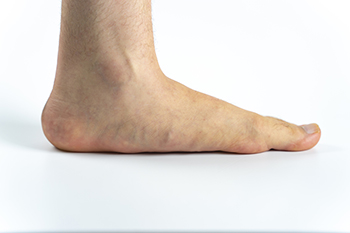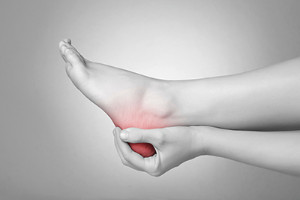Connect With Us
Blog
Items filtered by date: August 2023
Wounds That Don't Heal Need to Be Checked
When Flat Feet Cause Pain

Flat feet, or fallen arches, occur when the arch of the foot is lower than normal, potentially causing pain in various parts of the body. These lower arches can develop over time due to age and wear and tear on the feet. Children often have flat feet initially, but most develop a visible arch by around the age of 10. While flat feet may not always exhibit symptoms, they can lead to discomfort or pain in the heel, arch, or leg, and alter the alignment and functioning of the feet and legs during movement. Additional signs of flat feet may include uneven shoe wear, frequent tripping or falling, and stiffness or foot swelling. Conditions like Ehlers-Danlos syndrome, cerebral palsy, and muscular dystrophy can cause flat feet, as can factors such as being male, rheumatoid arthritis, diabetes, and obesity. Orthotics, exercises, weight management if necessary, and supportive footwear might help this condition. Surgery may be considered in some cases. If you have flat feet and they are causing you pain, it is suggested that you make an appointment with a podiatrist who can examine your feet and provide treatment to manage discomfort.
Flatfoot is a condition many people suffer from. If you have flat feet, contact Imaze Marian Davis, DPM from Marian Davis, DPM, PA. Our doctors will treat your foot and ankle needs.
What Are Flat Feet?
Flatfoot is a condition in which the arch of the foot is depressed and the sole of the foot is almost completely in contact with the ground. About 20-30% of the population generally has flat feet because their arches never formed during growth.
Conditions & Problems:
Having flat feet makes it difficult to run or walk because of the stress placed on the ankles.
Alignment – The general alignment of your legs can be disrupted, because the ankles move inward which can cause major discomfort.
Knees – If you have complications with your knees, flat feet can be a contributor to arthritis in that area.
Symptoms
- Pain around the heel or arch area
- Trouble standing on the tip toe
- Swelling around the inside of the ankle
- Flat look to one or both feet
- Having your shoes feel uneven when worn
Treatment
If you are experiencing pain and stress on the foot you may weaken the posterior tibial tendon, which runs around the inside of the ankle.
If you have any questions please feel free to contact our office located in Miami, FL . We offer the newest diagnostic and treatment technologies for all your foot and ankle needs.
Finding Shoes That Fit Properly

Finding shoes that fit properly is important for foot health and overall comfort. Different shoe brands vary in fit, due to factors like material and construction. Incorrect sizing and improper shoe fittings can result in foot problems. Regular refitting is essential because feet change over time due to factors like aging, foot deformities, or pregnancy. In some cases ligaments lose elasticity, arches fall, and foot size changes. When fitting a shoe, measurements using a Brannock device determine length and width, but it is also important to consider your weight, the purpose of the shoe, and the materials from which it is made. Foot width ranges from AAA to 6E, and choosing the right width matters in order to prevent issues like neuromas, corns, or painful skin folding. Wearing improperly fitted shoes can exacerbate problems like pronation or supination. Experts suggest avoiding shoes that allow the toes to touch the front, which can lead to toe pain, bunions, or hammertoes. If you have problem feet and need guidance in finding the right shoes, it is suggested that you make an appointment with a podiatrist for more information.
It is important to find shoes that fit you properly in order to avoid a variety of different foot problems. For more information about treatment, contact Imaze Marian Davis, DPM from Marian Davis, DPM, PA. Our doctors will treat your foot and ankle needs.
Proper Shoe Fitting
Shoes have many different functions. They cushion our body weight, protect our feet, and allow us to safely play sports. You should always make sure that the shoes you wear fit you properly in order to avoid injuries and deformities such as: bunions, corns, calluses, hammertoes, plantar fasciitis, stress fractures, and more. It is important to note that although a certain pair of shoes might be a great fit for someone else, that doesn’t mean they will be a great fit for you. This is why you should always try on shoes before buying them to make sure they are worth the investment. Typically, shoes need to be replaced ever six months to one year of regular use.
Tips for Proper Shoe Fitting
- Select a shoe that is shaped like your foot
- Don’t buy shoes that fit too tight, expecting them to stretch to fit
- Make sure there is enough space (3/8” to ½”) for your longest toe at the end of each shoe when you are standing up
- Walk in the shoes to make sure they fit and feel right
- Don’t select shoes by the size marked inside the shoe, but by how the shoe fits your foot
The shoes you buy should always feel as good as they look. Shoes that fit properly will last longer, feel better, and improve your way of life each day.
If you have any questions, please feel free to contact our office located in Miami, FL . We offer the newest diagnostic and treatment technologies for all your foot care needs.
Heel Pain in Growing Kids

Sever's disease is a common condition that causes heel pain in children experiencing growth spurts. It primarily affects active kids involved in sports and physical activities. This condition occurs when the growth plate at the back of the heel becomes inflamed due to repetitive stress and tension on the area where the Achilles tendon attaches to the bone. As children grow, the bones often grow faster than the surrounding muscles and tendons, leading to this painful condition. Sever's disease usually affects children and young teenagers between the ages of 8 to 14 years old. The treatment for Sever's disease focuses on relieving pain and reducing inflammation. Rest, and avoiding activities that aggravate the condition are the primary treatment measures. Gentle stretching and strengthening exercises may help improve flexibility and reduce stress on the affected area. In some cases, heel pads or orthotic shoe inserts may be recommended to provide additional support and cushioning. If the pain persists or worsens, it is suggested that you consult a podiatrist for proper evaluation and guidance on managing Sever's disease effectively.
Sever's disease often occurs in children and teens. If your child is experiencing foot or ankle pain, see Imaze Marian Davis, DPM from Marian Davis, DPM, PA. Our doctors can treat your child’s foot and ankle needs.
Sever’s Disease
Sever’s disease is also known as calcaneal apophysitis, which is a medical condition that causes heel pain I none or both feet. The disease is known to affect children between the ages of 8 and 14.
Sever’s disease occurs when part of the child’s heel known as the growth plate (calcaneal epiphysis) is attached to the Achilles tendon. This area can suffer injury when the muscles and tendons of the growing foot do not keep pace with bone growth. Therefore, the constant pain which one experiences at the back of the heel will make the child unable to put any weight on the heel. The child is then forced to walk on their toes.
Symptoms
Acute pain – Pain associated with Sever’s disease is usually felt in the heel when the child engages in physical activity such as walking, jumping and or running.
Highly active – Children who are very active are among the most susceptible in experiencing Sever’s disease, because of the stress and tension placed on their feet.
If you have any questions, please feel free to contact our office located in Miami, FL . We offer the newest diagnostic and treatment technologies for all your foot and ankle injuries.
What Can Cause Toenail Fungus?

Toenail fungus is a stubborn and unsightly foot condition. It often begins on the nail of the big toe and may travel to the other nails if treatment is not received. It is caused by a fungus that lives in warm and wet environments, such as public swimming pools, gym locker rooms, and similar places. The fungus can enter the body through tiny cracks that are on the skin of the feet. It is easy to prevent this from occurring by wearing flip-flops or water shoes while in these areas. There may also be existing medical conditions that can lead to the development of toenail fungus. These can include diabetes, poor circulation, or illnesses that can affect the immune system. It is beneficial to limit wearing pantyhose, which may cause the feet to sweat and be at risk of developing toenail fungus. If you have this condition, it is suggested that you confer with a podiatrist who can offer prescribed medication or other viable treatment options.
If left untreated, toenail fungus may spread to other toenails, skin, or even fingernails. If you suspect you have toenail fungus it is important to seek treatment right away. For more information about treatment, contact Imaze Marian Davis, DPM of Marian Davis, DPM, PA. Our doctors can provide the care you need to keep you pain-free and on your feet.
Symptoms
- Warped or oddly shaped nails
- Yellowish nails
- Loose/separated nail
- Buildup of bits and pieces of nail fragments under the nail
- Brittle, broken, thickened nail
Treatment
If self-care strategies and over-the-counter medications does not help your fungus, your podiatrist may give you a prescription drug instead. Even if you find relief from your toenail fungus symptoms, you may experience a repeat infection in the future.
Prevention
In order to prevent getting toenail fungus in the future, you should always make sure to wash your feet with soap and water. After washing, it is important to dry your feet thoroughly especially in between the toes. When trimming your toenails, be sure to trim straight across instead of in a rounded shape. It is crucial not to cover up discolored nails with nail polish because that will prevent your nail from being able to “breathe”.
In some cases, surgical procedure may be needed to remove the toenail fungus. Consult with your podiatrist about the best treatment options for your case of toenail fungus.
If you have any questions, please feel free to contact our office located in Miami, FL . We offer the newest diagnostic and treatment technologies for all your foot care needs.
What Causes Morton’s Neuroma?

The foot condition that is known as Morton’s neuroma is painful. It is caused by wearing shoes that do not have enough room in the toe area and it affects the nerve between the third and fourth toes. High heels can fall into this category, and women can develop this condition if high heels are worn often and for long periods of time. Patients may feel this affected nerve can be malignant, however, it is considered to be a benign growth. The pain is often felt in the ball of the foot, and it may be difficult to walk. Temporary relief may be found when wider shoes with lower heels are worn. There may be swelling that accompanies this ailment, and it can be helpful to elevate the feet. In severe cases, some patients may choose surgery that can remove the nerve, and normal activities may be resumed. If you have foot pain from for Morton’s neuroma, it is strongly suggested that you contact a podiatrist who can effectively diagnose and offer the correct treatment methods.
Morton’s neuroma is a very uncomfortable condition to live with. If you think you have Morton’s neuroma, contact Imaze Marian Davis, DPM of Marian Davis, DPM, PA. Our doctors will attend to all of your foot care needs and answer any of your related questions.
Morton’s Neuroma
Morton's neuroma is a painful foot condition that commonly affects the areas between the second and third or third and fourth toe, although other areas of the foot are also susceptible. Morton’s neuroma is caused by an inflamed nerve in the foot that is being squeezed and aggravated by surrounding bones.
What Increases the Chances of Having Morton’s Neuroma?
- Ill-fitting high heels or shoes that add pressure to the toe or foot
- Jogging, running or any sport that involves constant impact to the foot
- Flat feet, bunions, and any other foot deformities
Morton’s neuroma is a very treatable condition. Orthotics and shoe inserts can often be used to alleviate the pain on the forefront of the feet. In more severe cases, corticosteroids can also be prescribed. In order to figure out the best treatment for your neuroma, it’s recommended to seek the care of a podiatrist who can diagnose your condition and provide different treatment options.
If you have any questions, please feel free to contact our office located in Miami, FL . We offer the newest diagnostic and treatment technologies for all your foot care needs.




